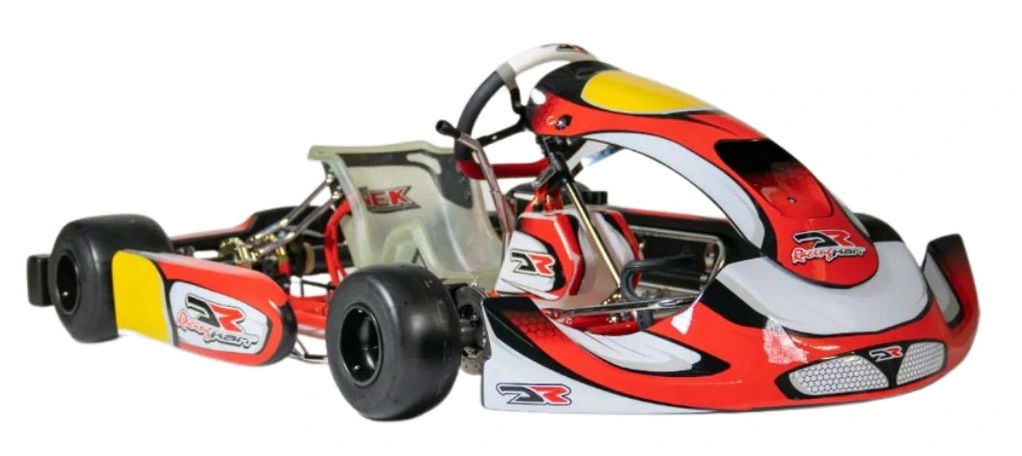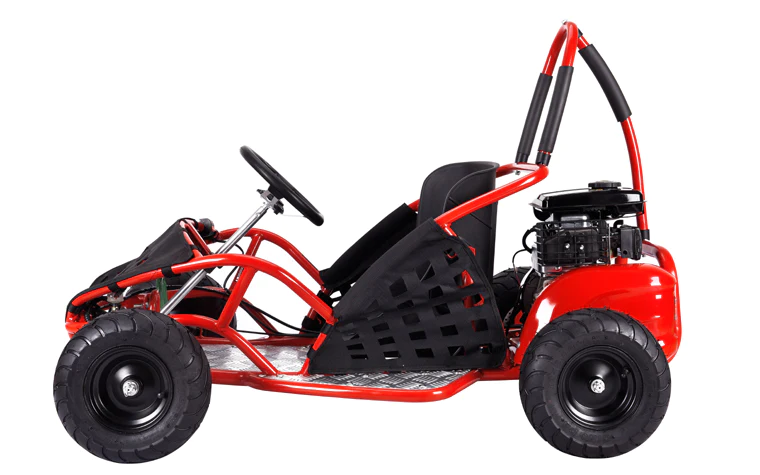The high-speed world of kart racing has captured the imaginations of thrill-seekers and motorsports enthusiasts for decades. The difference between a shifter kart and a go-kart becomes essential to understand within this adrenaline-fueled realm. While they may appear similar at first glance, there are notable differences in design, performance, and intended use.
For those new to the sport or intrigued by its nuances, understanding these distinctions is crucial when making your way around the track. In this article, we’ll take a closer look at the key factors that set shifters and go-karts apart while shedding light on their unique characteristics – ensuring you make an informed decision as both a driver and spectator in this exhilarating pursuit!
What Is A Shifter Kart?
A shifter kart is a specialized type of racing kart with a gearbox, allowing the driver to shift between multiple gears while driving. These high-performance machines are designed for experienced racers who seek the thrill of increased speed and superior acceleration in karting.

Typically equipped with powerful 125cc two-stroke engines, shifter karts can reach top speeds exceeding 80-100mph (160 km/h), making them significantly faster than regular go-karts.
In addition to their impressive speed capabilities, shifter karts also provide drivers with improved handling due to the sequential gearbox, which enables precise gear changes during cornering or when tackling different sections of a race track. With this added control and performance, shifter karts offer an exhilarating experience for seasoned motorsport enthusiasts looking for more challenging racing opportunities.
As you explore the world of karting further, it’s essential to understand how these advanced machines differ from traditional go-karts – so let’s dive into what makes them unique.
What Is A Go-Kart?
A go-kart is a small, four-wheeled vehicle for recreational and competitive motorsport events. These versatile karts are designed for drivers of all ages and skill levels, making them popular at karting tracks worldwide.

Unlike their shifter-kart counterparts, go-karts typically have a single-speed engine without a gearbox or clutch system. This makes them more accessible to novice drivers as there’s no need to worry about changing gears while navigating the track.
Go-karts come with various engine types – from low-powered electric motors to more powerful petrol engines (predominantly four-stroke). With top speeds ranging from 20 km/h (12 mph) for rental karts up to 120 km/h (75 mph) for professional race machines, there’s a go-kart suitable for everyone’s driving style and experience level.
Shifter Kart vs. Go-Kart Comparison
Shifters and go-karts have several differences that impact their performance, driving experience, and overall appeal for racers. Let’s explore some of these key distinctions:
Chassis
The chassis design is one of the main differences when comparing shifter karts and go-karts. A shifter kart typically has a more advanced, lightweight, and stiff chassis engineered for optimal track performance. Rigidity in the shifter kart’s chassis allows for better cornering and improved handling, enabling racers to achieve faster lap times.
On the other hand, a go-kart generally sports a simpler and more robust chassis built to withstand rental kart usage or amateur racing. This means that it may not have the same level of performance as its shifter counterparts but offers greater durability for beginners or casual karting enthusiasts.
By understanding the differences between these two types of kart frame structures, you can decide when entering your next raceway event or which kart class best fits your driving style.
Karting Engine
The engine is a vital component that sets shifter karts and go-karts apart. Shifter karts typically use high-performance, two-stroke engines that produce impressive power output for their size. Usually ranging from 125cc to 250cc, these engines offer significant torque and quick acceleration on the track.
In contrast, go-kart engines are often single-speed and can be either two-stroke or four-stroke. They generally have lower horsepower than shifter kart engines and are designed simply for recreational use or entry-level karting programs. The power of a go-kart engine may vary depending on its intended purpose – rental karts at kart tracks usually have less powerful motors than professional racing go-karts specifically built for competition.
Fuel
Fuel types play a significant role in karting’s performance and overall experience. Shifter karts and go-karts differ in the fuel used to power their engines.
Shifter karts, typically equipped with high-performance two-stroke engines, require a specific mixture of gasoline and oil for optimal performance. This mix ensures the engine is adequately lubricated, providing maximum power output while maintaining durability. Shifter karts sometimes use race-specific fuel formulations to boost their speed even further.
On the other hand, most common go-kart engines are four-stroke models that rely on standard gasoline as their primary fuel source. These engines are considerably less complicated than those found in shifter karts and don’t necessitate specialized fuels or intricate mixing procedures.
When choosing between a shifter kart and a go-kart, it’s essential to consider not only driving style but also factors such as cost, maintenance requirements, and fuel availability at your local kart track or racing facility, in addition to performance capabilities.
Transmission
One major aspect that sets shifters and go-karts apart is their transmission systems. Shifter karts are equipped with a manual gearbox, usually six gears, allowing the driver to fully control gear changes using a sequential shift lever. This enables precise adjustments during acceleration and cornering, leading to faster lap times.
On the other hand, traditional go-karts utilize a single-speed direct drive system with either an automatic or manual centrifugal clutch. This setup transfers the engine’s torque directly to the rear axle without changing the gear ratio. These types of karts provide easier handling for beginners yet still offer thrilling performance characteristics.
When comparing these transmissions in karting settings, more experienced racers may prefer shifter karts due to greater control over power delivery and vehicle dynamics. However, novice drivers can greatly benefit from simple-to-operate single-speed go-kart systems that focus on cultivating driving skills rather than mastering complex shifting mechanics.
Tires
Karting tires play a crucial role in performance and handling regarding karting. For both shifters and go-karts, selecting the right type of tire is essential to ensure optimal grip on the track.
Shifter karts usually use racing slicks known for their superior grip and consistency. These tires are designed for high-speed racing conditions, allowing racers to achieve greater cornering speeds and faster lap times. Shifter karts may also use rain tires when weather conditions require them.
On the other hand, go-karts tend to have all-purpose tires suitable for various track surfaces found at recreational or rental kart facilities. These tires provide decent grip and durability but might not offer the same level of performance as those found on professional race karts.
Cost
The cost is essential when selecting a kart for your racing experience. While shifters and go-karts provide thrilling rides, they differ in price range due to their varying features and capabilities.
Shifter karts, considered top-tier racing machines, come with more advanced technology, such as gearbox systems and powerful engines. Consequently, they tend to be significantly more expensive compared to most go-karts. Besides the initial purchase cost, you should also account for the maintenance expenses associated with these professional-grade karts, including engine upkeep, transmission servicing, and tire replacements.
On the other hand, go-karts offer a more budget-friendly alternative that allows racers to enjoy exciting races on kart tracks. Commonly featuring single-speed engines with centrifugal clutches or even electric motors in some cases, go-kart costs can vary greatly depending on their class – from affordable entry-level options like rental karts up to high-performance classes such as Rotax or touch-and-go (TAG) categories.
| Type of Kart | Average Cost |
|---|---|
| Go Kart | $1,000 – $5,000 |
| Shifter Kart | $5,000 – $15,000 |
| Type of Kart | Model Name | Average Cost |
|---|---|---|
| Go Kart | Razor Ground Force Drifter Fury | $349.99 |
| Go Kart | Coleman Powersports CK100-S | $999.00 |
| Go Kart | Bintelli S1 Racing Go Kart | $3,299.00 |
| Go Kart | Tony Kart Racer 401R | $5,595.00 |
| Shifter Kart | CKR SG3 Shifter Kart | $6,295.00 |
| Shifter Kart | CRG Heron | $7,495.00 |
| Shifter Kart | Praga Dragon Evo 2 | $10,400.00 |
| Shifter Kart | Birel ART Shifter Kart | $15,295.00 |
It’s important to note that these prices are averages and can vary based on location, features, and customization options. Also, prices may not include additional costs such as shipping, taxes, or assembly fees.
Pros and Cons of Shifter Karts and Go-Karts
Both shifters and go-karts have unique characteristics that make them appealing to different types of drivers. Here, we’ll discuss the pros and cons of each kart type to help you weigh your options.
Shifter Karts Pros and Cons
Pros
- Greater top speed due to powerful engines, gearbox, and clutch
- Faster lap times thanks to better acceleration, torque, and cornering capabilities
- Sequential gearboxes offer more control over the kart’s performance
- Suitable for experienced racers seeking a challenging motorsport experience
Cons
- The higher initial cost for the kart itself, as well as maintenance expenses
- More complex driving techniques required (e.g., manual gear shifting)
- Not ideal for beginners or casual recreational use
Go-Karts Pros and Cons
Pros
- Easier to handle with single-speed engines or automatic transmissions
- Lower entry costs make them more accessible for beginners or rental kart experiences
- The simpler operation allows drivers to focus on learning fundamental racing skills like throttle control and braking.
Cons
- Slower top speeds compared to shifter karts limit their appeal in professional race settings.
- Less engaging driving experience due to fewer advanced controls
Choosing between a shifter kart and a go-kart depends on your goal in your karting journey. Standard go-karts might be the best choice if you’re beginning or looking for an enjoyable hobby at a local go-kart track without too much complexity. However, if you desire an adrenaline-pumping challenge that pushes both skill level and vehicle performance limits within motorsports circles involving gearbox-controlled vehicles like Formula One cars or IndyCar racing machines, opting for a shifter Kart could be right up your alley!
Conclusion
The key differences between a shifter and a go-kart lie in their chassis design, engine type, fuel consumption, transmission system, tires, and cost. Shifter karts offer more advanced features, such as gearbox clutches and multiple gears for faster acceleration and higher top speeds than single-speed go-karts with direct-drive engines.
While shifter karts cater to experienced racers seeking adrenaline-pumping performance on professional tracks, go-karts are versatile options suitable for beginners or recreational use at rental kart facilities. Ultimately, both racing machines provide unique experiences that cater to different skill sets and preferences within the thrilling world of karting.

Goran, an experienced go-kart racer, fuels GoKartLife.com with his passion and expertise. He offers valuable insights and tips for fellow enthusiasts, fostering the growth of the go-kart community. Join Goran at GoKartLife.com and immerse yourself in this exhilarating sport.
Last modified: February 16, 2025



